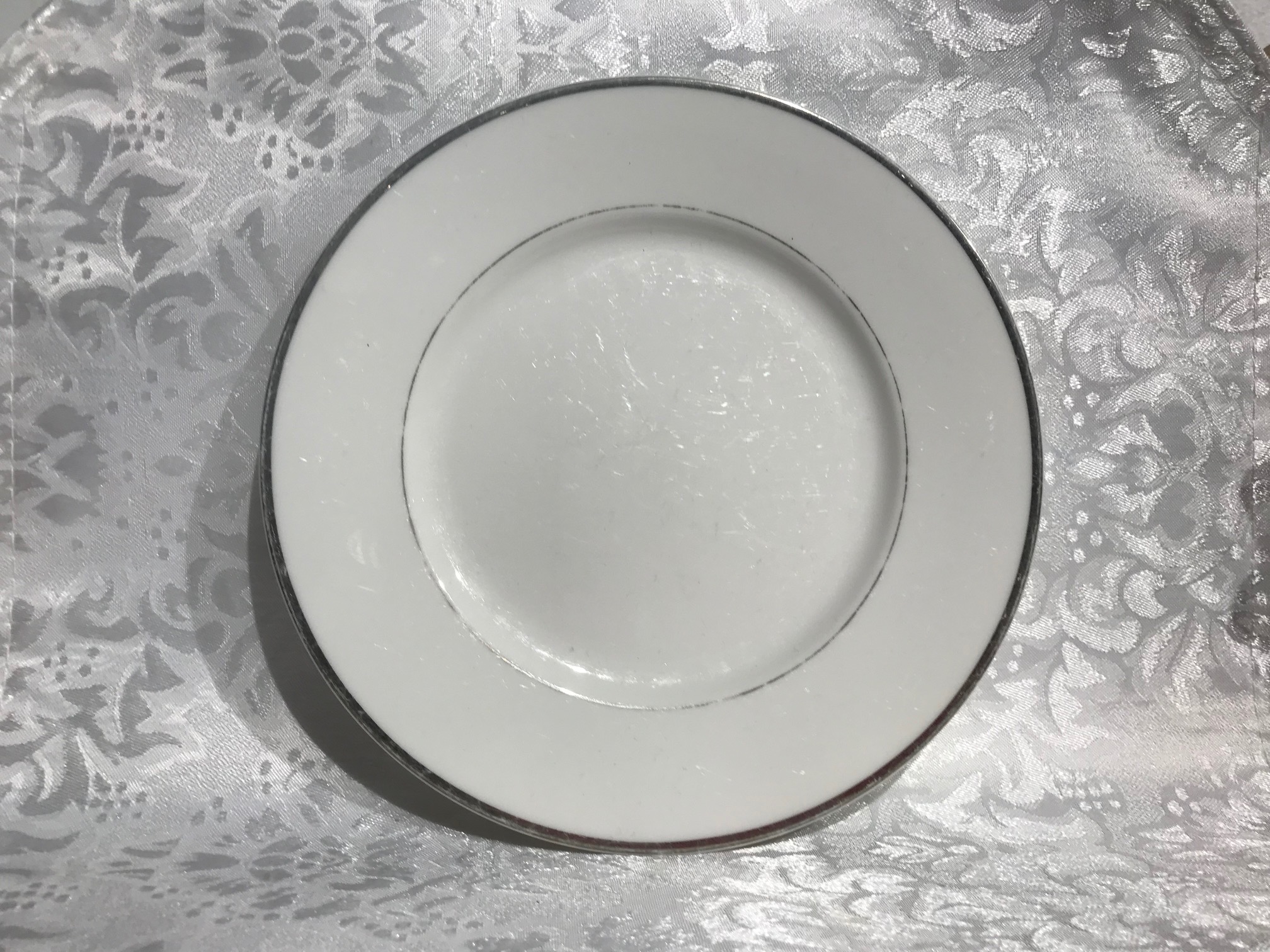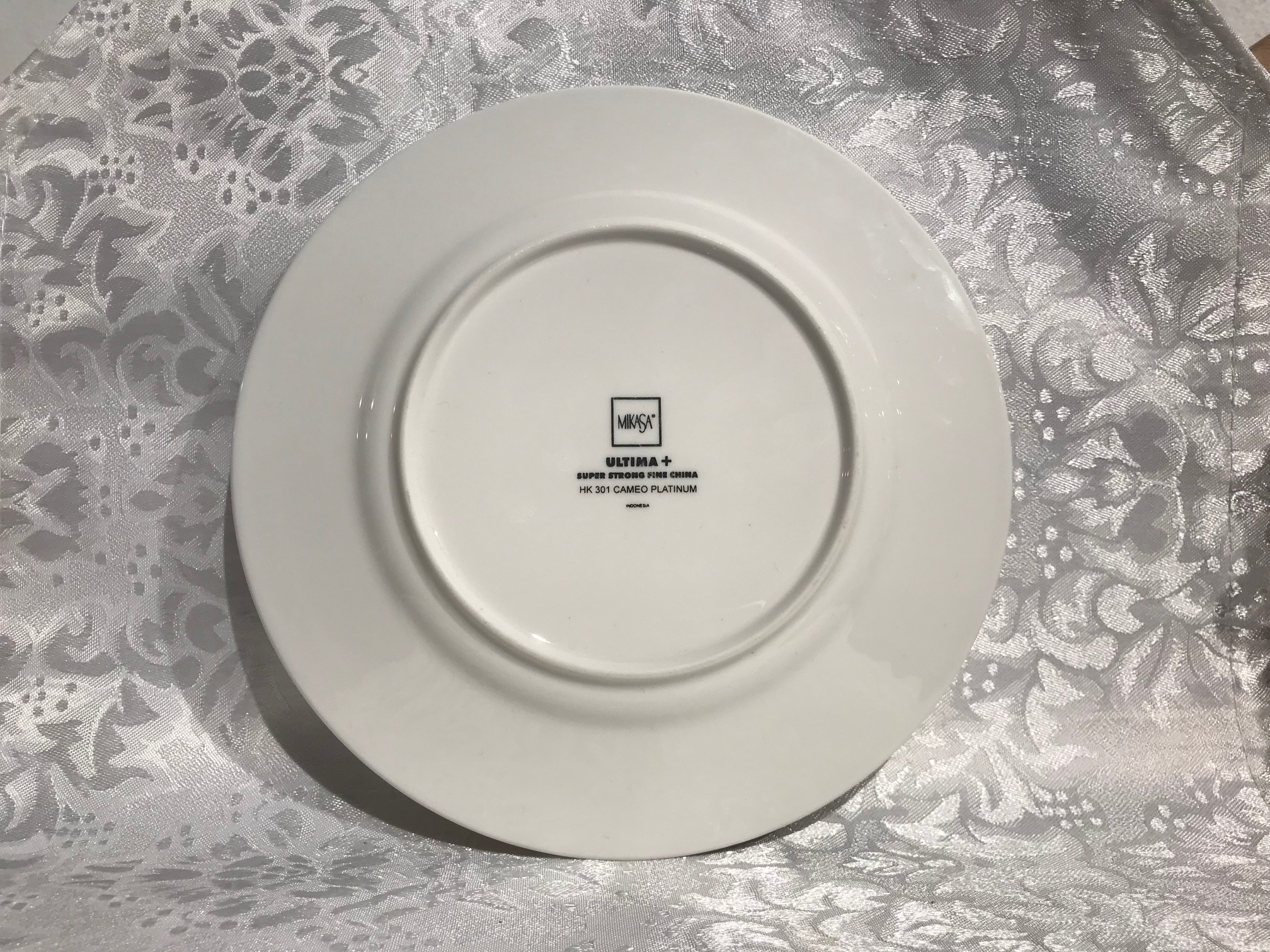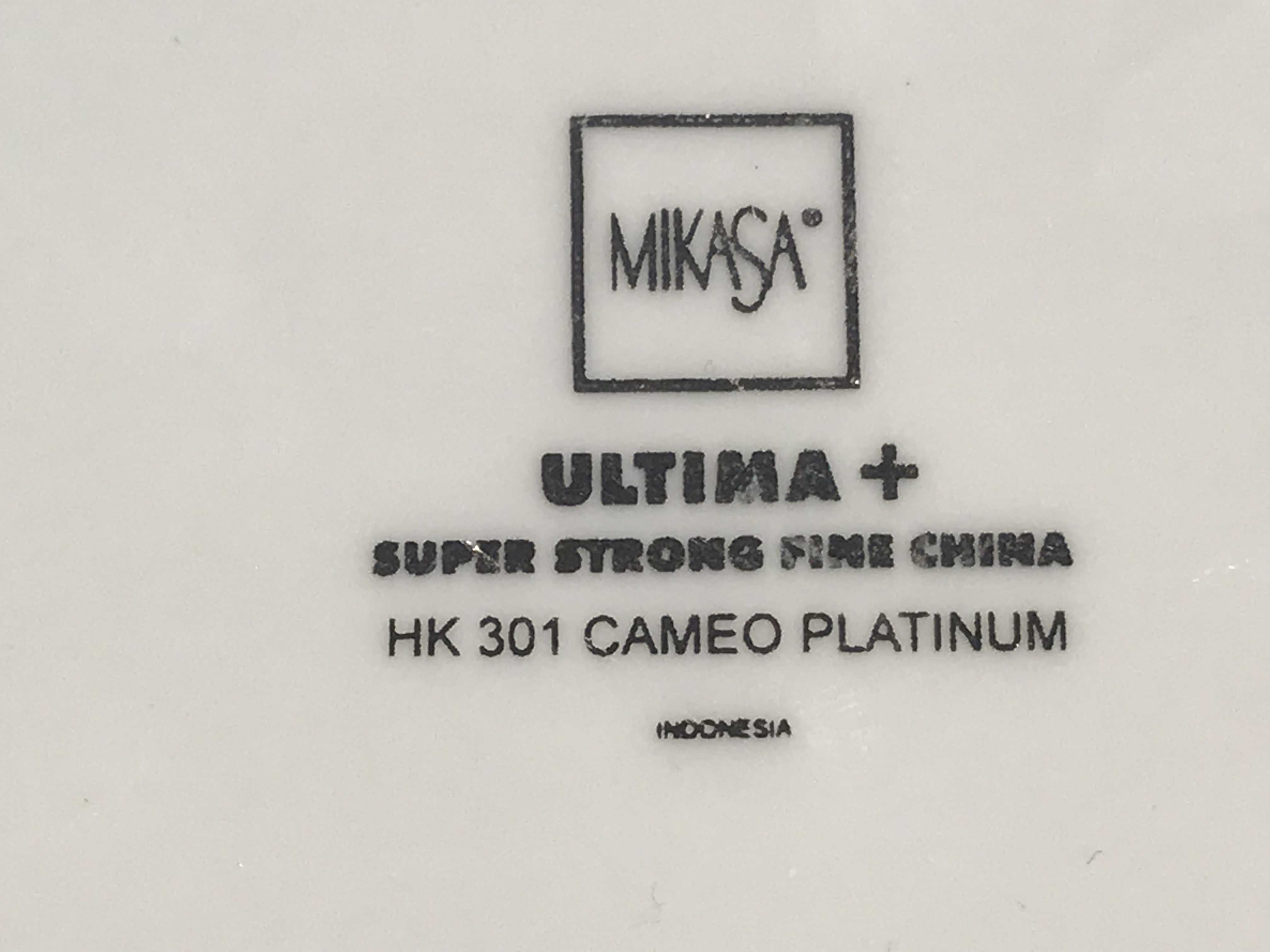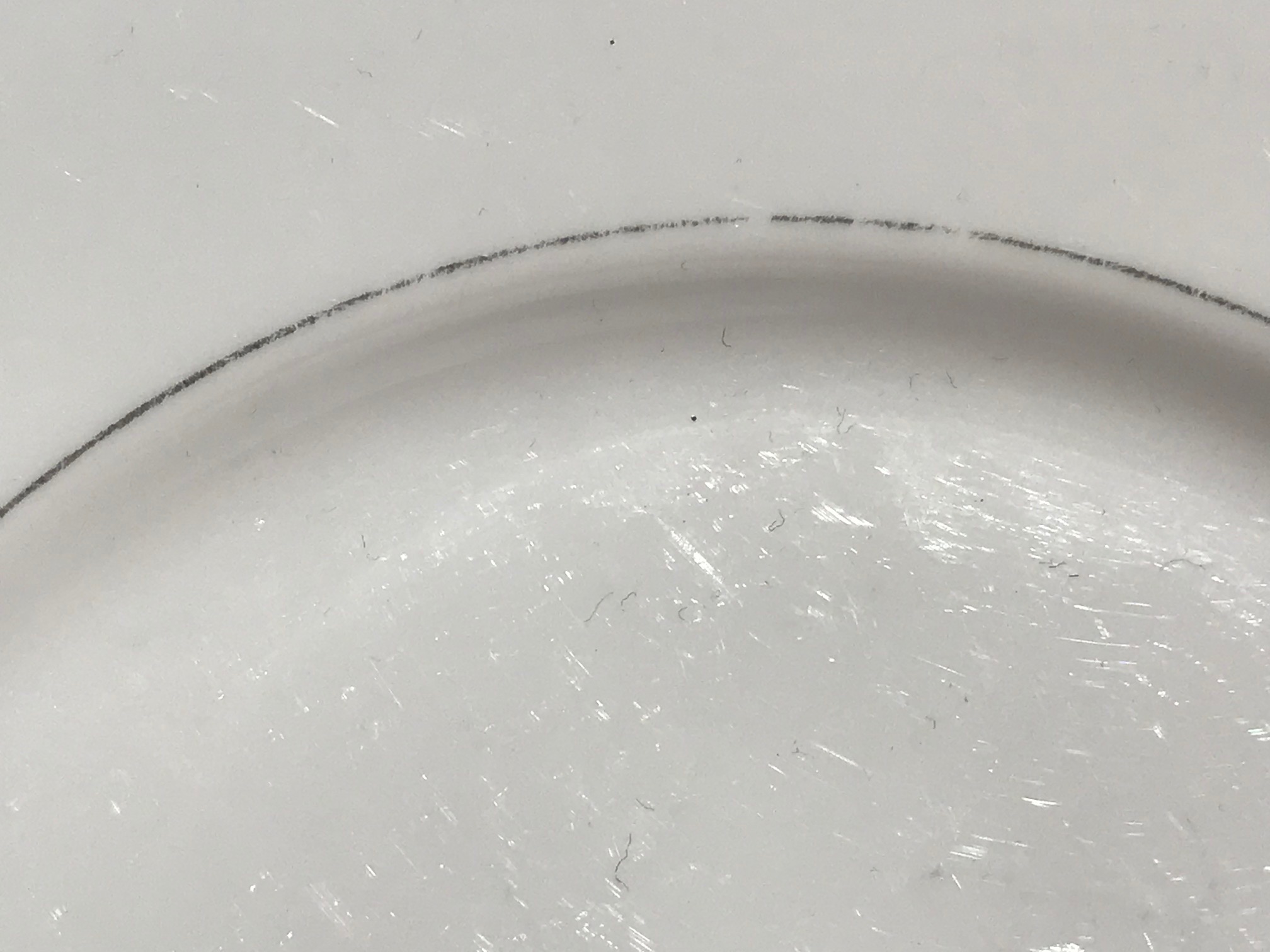Mikasa Ultima+ HK 301 Cameo Platinum: 57,500 ppm Lead in the glaze – a likely source of poisoning of a child.


 When tested with an XRF instrument the dish pictured here (a Mikasa Ultima+ HK 301 Cameo Platinum design dish – Made in Indonesia) had the following readings:
When tested with an XRF instrument the dish pictured here (a Mikasa Ultima+ HK 301 Cameo Platinum design dish – Made in Indonesia) had the following readings:
1.) Reading in the white center / food surface of the dish:
- Lead (Pb): 57,500 +/- 1,700 ppm
- Zinc (Zn): 1,155 +/- 90 ppm
- Iron (Fe): 915 +/- 198 ppm
- Vanadium (V): 78 +/- 33 ppm
- Titanium (Ti): 260 +/- 58 ppm
- Non-Detect (Negative) for Cadmium, Arsenic, Antimony and Mercury.
2. ) Reading on the food surface of the dish – including platinum edging area:
- Lead (Pb): 49,000 +/- 1,300 ppm
- Gold (Au): 629 +/- 103 ppm
- Zinc (Zn): 1,058 +/- 82 ppm
- Iron (Fe): 761 +/- 181 ppm
- Vanadium (V): 78 +/- 31 ppm
- Titanium (Ti): 258 +/- 54 ppm
- Non-Detect (Negative) for Cadmium, Arsenic, Antimony and Mercury.
To learn more about XRF testing, click here.
All results reported on this blog are science-based, and replicable. Testing is done for a minimum of 60 seconds per component unless otherwise noted. Components are tested multiple times to confirm the levels of toxicants found. The XRF instrument used is the Niton XL3T – the same instrument used by the United States Consumer Product Safety Commission (CPSC) for testing for Lead in consumer goods. Metals not detected by the XRF instrument (in “consumer goods” mode) are not listed in the above reading set.
How much Lead is “too much” Lead?
For context, the amount of Lead that is considered unsafe (and illegal) in newly manufactured products “intended for use by children” is anything 90 ppm or higher in the paint, glaze or coating and anything 100 ppm or higher in the substrate (in the case of a ceramic dish, this would be the base ceramic of the dish – under the glaze.) The standards for children’s items are for XRF-detectable total Lead content (not leach-test results – which is a different standard / different type of testing.) 57,500 ppm Lead is considerably higher than 90 ppm Lead!!!!!
This dish was used daily by a child who was sick for many years and tested positive for high levels of Lead. You can read more about his story here.
How is it legal for a dish to have this much Lead?
Dishes are not regulated in the same way as items intended for use by children – as they are not considered (by our regulatory agencies) to be “items intended for use by children.” Antique and vintage dishware were subjected to even less stringent regulatory standards (or none at all, depending on the year made) than modern dishware. Modern dishware needs to comply with leach testing standards at the time of manufacture – but may still contain high levels of Lead in the glaze or substrate. Even modern regulatory standards do not attempt measure, govern or restrict how much Lead may potentially leach from dishes in the future with regular daily use (over years or decades of normal use as intended.) In my opinion, this is a significant regulatory loophole — as frankly I don’t know any children who don’t use dishes and I firmly believe that all dishes should be regulated to at least the same strict standards as items intended for use by children (they should be required to have glaze/paint/coating or decorative elements that is under 90 ppm Lead – as detectable with an XRF instrument.)
To read more about the concern for Lead in vintage and new pottery items, click here.
To see more “Made in Indonesia” pieces I have tested, click here.
To see more Mikasa pieces I have tested, click here.
As always, thank you for reading and for sharing my posts.
Please let me know if you have any questions.
Tamara Rubin
#LeadSafeMama 
Never Miss an Important Article Again!
Join our Email List



 When tested with an XRF instrument the dish pictured here (a Mikasa Ultima+ HK 301 Cameo Platinum design dish – Made in Indonesia) had the following readings:
When tested with an XRF instrument the dish pictured here (a Mikasa Ultima+ HK 301 Cameo Platinum design dish – Made in Indonesia) had the following readings:
Thank you for helping this family, and so many others, Tamara. I have questions.
1. Did the mom also use these dishes and the crystal glassware?
2. Did the mom show elevated lead levels in her blood too?
3. What regulatory agencies make the rules about how much lead is allowed to be in items used by children?
4. How can we get those regulatory agencies to add dishes, and other items?
Hi Sheryl!
Other people in the family were also impacted as I understand it – however mom was most concerned about her son who was more symptomatic. The CPSC (Consumer Product Safety Commission) is the agency that regulates items intended for use by children and YES – it would be amazing to get dishes added (all dishes) to the items they regulate. So far there has been no response to my inquiries and they only regulate dishes that are expressly made for use by children (baby dishes) to the same strict standards that they regulate other children’s items.
Tamara
What about just starting a petition on your site? And then asking your followers to bug them until they do the right thing? This is insane.
It should also be law that sellers on eBay and such HAVE to warn buyers about these heavy metals.
Hi Tamara,
Thank you for the great info. Actually, I just have purchased Mikasa Trellis to replace the Lenox Poppies on Blue which I have been using everyday. But now I wonder if I should test Trellis before starting to use.
What is the best way to test the item I purchased ? Thank you in advance for your frank advice.
Youngi
Is it new or old. New (brand new) should be at least lead-safe (possibly high lead in the back mark). If it is more than 6 years old (like from replacements) it could have high lead in the surface glaze. I generally do not like the brand at all. These cannot be tested at home for total lead content. Here’s the link to send a dish in for testing – but answer those q’s first:
https://tamararubin.com/2019/08/tamara-can-i-send-you-one-of-my-dishes-to-test-for-lead/
t
Thank you, Tamara, for your work to raise awareness of lead poisoning and help people make safe choices for their health.
I have a set of Mikasa Ultima + super strong fine china HK 302 Cameo Gold made in Indonesia.
I am wondering if it has lead like the Mikasa HK 301 Cameo Platinum listed above.
Have you tested this pottery?
I think it would depend on the age. How long have you had yours? Do you know what year it was manufactured?
T
It was purchased around 2004 from an outlet mall.
2004 Mikasa is likely to be positive for high levels of Lead.
T
I think I own this set, which I mostly received in 2012 as wedding gifts from Macy’s, would you think those are likely contaminated too? I am having trouble wrapping my head around this loophole, it’s ridiculous.
2012 is on the fence – I don’t know for sure as I haven’t tested any that I know were from that year and it’s possible they are contaminated with Lead but also possibly they are lead-safe or Lead-free. It seems they shifted manufacturing processes for many of their designs about ten years ago.
I have Ultima + set, but the HK 400 Antique White. I have no idea when they were purchased and Mikasa hasn’t been able to tell me the age of the plates. Mine are just white, but your article says it’s in the glaze… Better safe than sorry? I hate to get rid of good plates…
I purchased a 92 piece set of HK301 Cameo Platinum china directly from Mikasa (email dated 11/17/09 for item HK301-092 for $674.99 from Lifetime Brands) in November of 2009. I recently purchased the Lumetallix: Instant Lead Test Kit and used it to test 5 different pieces of my Mikasa china set. All the pieces tested negative. Do you think it is safe to use?